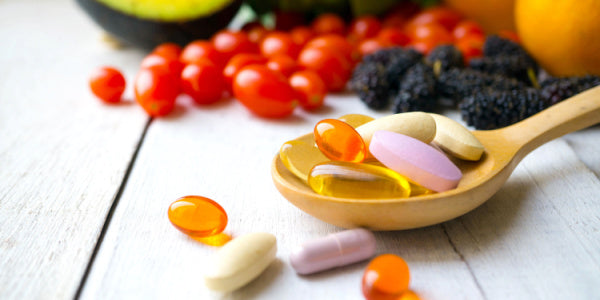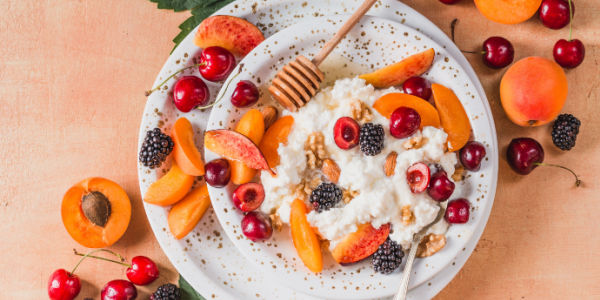
Since ancient times, healers have insisted that food is medicine and advised prioritizing diet as a means of obtaining better health. Using food as medicine may seem like an outdated concept at first glance.
However, modern-day science suggests that a food as medicine diet may be the key to preventing chronic diseases. Keep reading for the top five tips on how to use food as medicine.
What Is Food As Medicine?
As it turns out, the proverb “an apple a day keeps the doctor away” might actually be true. Since ancient times, certain foods have been prescribed as a form of medicine. This practice continues today, but is commonly referred to as a concept called “food as medicine” or “food is medicine.”
Other names for food as medicine include food therapy, medicated diets or medicated diet therapy, and medicinal foods. From broader prevention policies to more specialized treatment protocols, food as medicine is becoming more mainstream in meal planning.
Some examples of food being used as medicine in health care include:
• Culinary medicine programs and teaching kitchens
• Food referral programs
• Medically tailored meals (food packages) and groceries
• Produce prescriptions (i.e. fruit and vegetables)
It’s no secret that poor diet is linked to many health conditions and diet-related chronic diseases, such as heart diseases (e.g. cardiovascular disease) and type 2 diabetes. On the other hand, a healthy diet can reduce disease risk and play a vital role in recovery or remission.
Beyond reducing disease risk, using food as medicine may help you accomplish other health goals. For example, eating more healthy foods can help you on your weight loss journey or help you balance blood sugar levels.
How to Use Food As Medicine
Interested in using food as medicine but don’t know where to start? Here are five easy, approachable ways to use food for health and healing.
Prevent and Treat Deficiencies with Food First
The word “vitamin” shares a root with the word “vital”, showing how important and crucial vitamins are for daily life. Vitamin deficiencies can cause serious problems and even lead to malnutrition.
Even though the medicine market—a.k.a. the pharmaceutical industry—is becoming more plant-based over time, it’s rare that artificially-created drugs and supplements can match the bioavailability of compounds found naturally in plants. For example, colorful fruits and vegetables naturally contain compounds called flavonoids that may help manage many conditions (from high blood pressure to insulin resistance).
Many dietitians recommend taking a “foods first” approach to diet, meaning instead of starting with supplements, you aim first to eat foods rich in the vitamins and minerals you are missing. Supplements often contain isolated forms of a vitamin or mineral, so you may be missing out on other nutrients naturally contained in a food source.
In other words, consuming foods first (instead of skipping straight to supplements) is food as medicine at its finest. Think of nutrient-rich foods, like fruits and veggies, as nature’s multivitamins!
Eat More Fermented Foods
Speaking of supplements, probiotic pills have become more popular in recent years. However, did you know probiotics (“good” bacteria) exist naturally in some fermented foods?
Like other medicinal foods, fermented foods and beverages have been consumed historically across many ancient societies. For example, the fermented milk drink kefir is thought to have originated in the Caucasus region. Traditionally, it was utilized for its supposed health benefits, including improvements to:
• Allergies
• Gastrointestinal (gut) problems
• Heart disease
• Hypertension
Today, research supports the consumption of kefir due to its established probiotic profile and potential to help control cholesterol. In fact, some studies have suggested that probiotic foods like kefir may be prescribed in the future alongside (or even in place of) antibiotics. Much more research is needed to get to that point, but until then, probiotics look promising.
Since many medicines and antibiotics can alter gut bacteria and cause uncomfortable symptoms, fermented foods may be a natural way to provide the benefits the body needs. A prescription for probiotic-rich foods may prove especially helpful to those with sensitive stomachs looking to rebuild good bacteria in the gut.
Not a fan of kefir? That’s okay! There are plenty of other probiotic-rich foods to consume, including:
• Aged cheeses
• Cultured non-dairy products
• Kimchi
• Kombucha
• Miso
• Pickles and pickled foods
• Sauerkraut
• Tempeh
• Yogurt
Explore Functional Foods and Nutraceuticals
Although the phrase “functional foods” has been around for a few decades, it’s still considered an emerging concept. In most circles, functional foods are thought to contain vitamins, minerals, and other nutrients beyond normal levels. Essentially, these foods are so nutritious they are believed to offer medicine-like benefits (but without the side effects).
These foods are sometimes called nutraceuticals, a word combining aspects of two other words, “nutrition” and “pharmaceuticals”. Nutraceutical foods and supplements are believed to have health-giving properties and may provide some sort of medicinal benefit.
Honey is a great example of functional food that is widely known for its nutraceutical properties. Historically, honey was used as both a sweetener and health aid, helping ancient peoples deal with disorders of the heart and gastrointestinal system. More commonly in modern times, it’s used as a main flavoring agent and ingredient in cough drops (thanks to antibacterial and antioxidant properties).
In reality, all foods are functional because they accomplish a certain function and provide a certain benefit to the body. However, some foods are so “functional” that they are believed to provide extra benefits. Some of these foods include:
• Beans
• Berries
• Fish
• Nuts and seeds
• Whole grains
Dive Deeper Into History & Cultural Cuisine
Ready to try food as a form of medicine, but searching for inspiration to start? While the Western diet is known to be nutritionally deficient in many ways, Eastern eating patterns have utilized medicinal foods for centuries.
Many traditional Eastern dishes naturally include the readily available plants of the area. This is not because science supported it immediately since its inception, but rather because the ingredients were available and known for their natural health benefits!
For example, long before dairy allergies necessitated alternative milks, people used plant-based milk. Dishes like Thai curries traditionally use coconut milk as a base, making the food both nutritious and delicious. Science is catching up to confirm the health benefits of plant-based milk, which include naturally low levels of saturated fats, higher levels of healthy fats (like omega-3 fatty acids), and high antioxidant activity.
Eastern diets aren’t the only diets that favor plant foods over processed food. Mediterranean diets are also recommended commonly in medical settings since they include plenty of plant-based foods that have health benefits.
Doctors and dietitians regularly recommend this diet pattern for people looking to prevent or treat the following:
• Bone loss
• Cancer
• Declining mental function or worsening brain health
• Heart problems
• Metabolic syndrome
• Type 2 diabetes
• Weight gain
Plus, people eating according to these patterns have been studied over time and are known to outlive others in their generation! Researchers largely attribute this to the type of foods they’re eating and how they treat food as a form of medicine. They are living proof that the saying “you can pay your farmer now or your doctor later” has merit.
Explore Your Assistance Options
If you believe that “food as medicine” isn’t affordable, this section is for you! A little nutrition education can go a long way in helping you select medicinal foods that fit into your assistance program or plan.
Search for the following types of functional foods when using government-assisted grocery plans:
• Dairy and plant-based alternatives
• Fruits and vegetables
• Lean meats
• Legumes (i.e. beans, peas, and lentils)
• Nuts and seeds
• Whole grains
Don’t know where to begin when it comes to finding food as medicine through government assistance? The U.S. Department of Agriculture has a list of Food Assistance Programs that can help you discern if you’re eligible and assist you in finding the program that’s the right fit for you.
Attending a one-time class or online session on using food as medicine can also help you adopt some skills. Many dietitians host classes or webinars that can help you find out more about using food in a preventative capacity.
Food As Medicine Diet: 3-Day Meal Plan Examples
The truth is that many foods can fit into a “food as medicine” diet. The following pattern can help you become more familiar with some of the most nutrient-rich, functional foods available.
Day 1:
• Breakfast: Maple Cranberry Orange Yogurt Parfait
• Lunch: Fresh Tabbouleh Salad with Quinoa and Stewed Italian White Beans
• Dinner: Healthy Parmesan Shrimp Risotto (made with riced cauliflower)
• Snack: Mushroom, Caramelized Onion and Goat Cheese Bruschetta
Day 2:
• Breakfast: Peach, Raspberry & Basil High-Protein Smoothie
• Lunch: BBQ Jackfruit with Southern-Style Black-Eyed Peas & Kale (order from bistroMD or make BBQ Jackfruit Sandwiches with Avocado Slaw instead)
• Dinner: Creole Tomato Okra Stew and Blackened Salmon
• Snack: Healthy Nut Mix
Day 3:
• Breakfast: Overnight Oats
• Lunch: Seasonal Vegetables with Thai Orange Sesame Sauce and Thai Green Papaya Salad
• Dinner: Authentic Chana Masala and Cumin Basmati Rice (made with brown rice)
• Snack: Golden Banana Milk (made with turmeric and black pepper)
A Final Word on Food Is Medicine
Whether you’re looking for a complete diet overhaul or simply wishing to eat more intentionally, a “food as medicine” approach may be for you. Even as supplements and medications become more plant-based, most diet experts prefer a “food first” approach to getting your vitamins and minerals.
Fortunately, consuming food as a form of medicine for your body can be both delicious and nutritious!
References
Albaridi NA. Antibacterial Potency of Honey. Int J Microbiol. 2019;2019:2464507.
Alexis AC. Can food be medicine? Pros and cons. Medicalnewstoday.com. Published April 2022.
Aydar EF, Tutuncu S, Ozcelik B. Plant-based milk substitutes: Bioactive compounds, conventional and novel processes, bioavailability studies, and health effects. J Funct Foods. 2020;70:103975.
Begum SB, Roobia RR, Karthikeyan M, Murugappan RM. Validation of nutraceutical properties of honey and probiotic potential of its innate microflora. LWT - Food Sci Technol. 2015;60(2):743-750.
Blue Zones. Secrets of the Mediterranean Diet. Bluezones.com. Published September 2011.
Blue Zones. 12 Mouthwatering Mediterranean Meals. Bluezones.com. Published October 2018.
Dictionary.com. Apple a day. Dictionary.com. Accessed April 2023.
Ellis E. Functional Foods. Eatright.org. Published January 2022.
Goswami HK, Ram HK. Ancient Food Habits Dictate that Food Can Be Medicine but Medicine Cannot Be “Food”!! Medicines (Basel). 2017;4(4):82.
Majtan J, Bucekova M, Kafantaris I, Szweda P, Hammer K, Mossialos D. Honey antibacterial activity: A neglected aspect of honey quality assurance as functional food. Trends Food Sci Technol. 2021;118(B):870-886.
National Institutes of Health. Food is Medicine Networks or Centers of Excellence. Dpcpsi.nih.gov. Accessed April 2023.
Rattray FP, O’Connell MJ. Encyclopedia of Dairy Sciences. 2nd ed., Academic Press, 2011.
Ramalingum N, Mahomoodally MF. The Therapeutic Potential of Medicinal Foods. Adv Pharmacol Sci. 2014;2014:354264.
Silva DR, Sardi JCO, Pitangui NS, Roque SM, Silva ACB, Rosalen PL. Probiotics as an alternative antimicrobial therapy: Current reality and future directions. J Funct Foods. 2020;73:104080.
St. Luke’s Health. 5 Medicinal foods from around the world to use in your cooking. Stlukeshealth.org. Published March 2022.
Sudhanshu SB, Sheikha AFE, Hammami R, Kumar A. Traditionally fermented pickles: How the microbial diversity associated with their nutritional and health benefits. J Funct Foods. 2020;70:103971.







